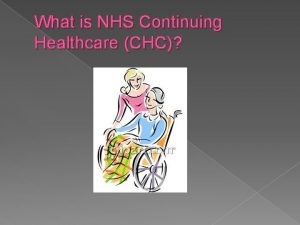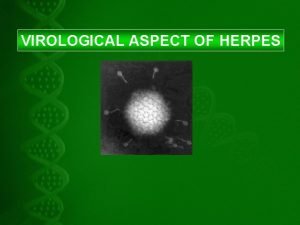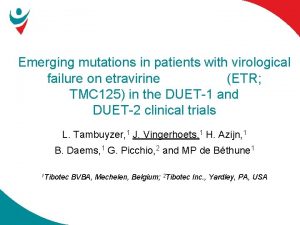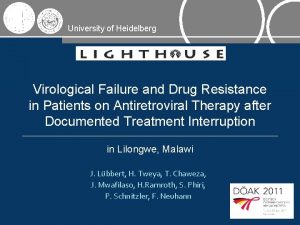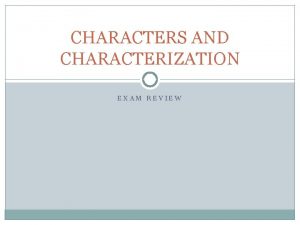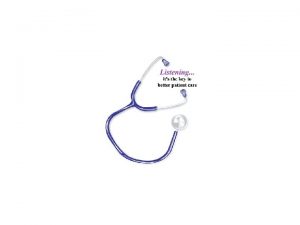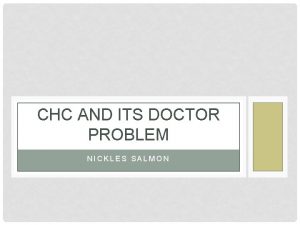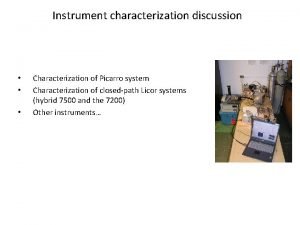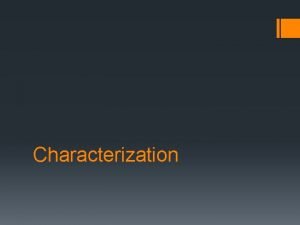Virological characterization of patients with CHC and failure

















- Slides: 17

Virological characterization of patients with CHC and failure to a glecaprevir/pibrentasvir or voxilaprevir/velpatasvir/sofosbuvir treatment in the international SHARED collaboration Adolfo de Salazar 1, Julia Dietz 2, Velia Chiara Di Maio 3, Slim Fourati 4, Beat Müllhaupt 5, Stefania Paolucci 6, Joaquin Cabezas 7, Rudolf E. Stauber 8, Nicola Coppola 9, Juan Arenas 10, Christiana Graf 2, Miguel Jiménez. Pérez 11, Elisabetta Degasperi 12, Juan Manuel Pascasio 13, Maria Paola Callegaro 14, Johannes Vermehren 2, Jose Miguel Rosales Zabal 15, Giovanni Battista Gaeta 9, Miguel Garcia-Deltoro 16, Heinz Zoller 17, Massimo Puoti 18, Christoph Berg 19, Mark Douglas 20, Jean-Michel Pawlotsky 4, Anita Howe 21, Federico Garcia 1, Francesca Ceccherini Silberstein 3, Christoph Sarrazin 2 22 1 University Hospital San Cecilio, Clinical Microbiology Unit, Spain, 2 University Hospital Frankfurt, Department of Internal Medicine 1, Germany, 3 University of Rome Tor Vergata, Department of Experimental Medicine, Italy, 4 Hôpital Henri Mondor, Department of Virology, France, 5 University Hospital Zürich, Swiss Hepato-Pancreato-Biliary Center and Department of Gastroenterology and Hepatology, Switzerland, 6 Irccs Policlinic Foundation San Matteo, Molecular Virology Unit, Microbiology and Virology Department, 7 Italy, Marqués de Valdecilla University Hospital, Departament of Hepatology, Spain, 8 Medical University of Graz, Department of Gastroenterology and Hepatology, Austria, 9 University of Study in Campania L. Vanvitelli, Department of Mental Health and Public Medicine, Infectious Diseases Unit, Italy, 10 University Hospital Donostia, Infectious Diseases Unit, Spain, 11 Hospital Regional de Málaga, Hepatology Unit, Spain, 12 University of Milan, Division of Gastroenterology and Hepatology, Italy, 13 University Hospital Virgen del Rocío, Hepatology Unit, Spain, 14 ASST Papa Giovanni XXIII, Department of Laboratory Medicine, Italy, 15 Hospital Costa del Sol, Gastrointestinal Unit, Spain, 16 Hospital General de Valencia, Infectious Diseases Unit, Spain, 17 Medical University of Innsbruck, Department of Medicine I, Gastroenterology, Hepatology and Endocrinology, Austria, 18 ASST Grande Ospedale Metropolitano Niguarda, Infectious Diseases Unit, Italy, 19 University of Tübingen, Department of Internal Medicine I, Germany, 20 University of Sydney and Westmead Hospital, Westmead Institute for Medical Research, Australia, 21 St Paul's Hospital, Centre for Excellence in HIV/AIDS, Canada, 22 St. Josefs Hospital, Medizinische Klinik 2, Germany

Conflicts of Interests • Grants, adboards, travelling and educational activities from • Abbvie • Gilead • MSD • Janssen • Vii. V • Qiagen • Roche

Background • Pangenotypic regimens Glecaprevir and Pibrentasvir (GP) and Voxilaprevir/Velpatasvir/Sofosbuvir (VVS) share: • High barrier to resistance • Potent activity against strains with common NS 3 and NS 5 A polymorphisms • Treatment of chronic hepatitis C virus (HCV) infection with GP or VVS results in high sustained virologic response (SVR) rates both in clinical trials and real world. • Information on resistance and retreatment of patients failing GP or VVS is scarce

SHARED Surveillance of Hepatitis-C Antiviral Resistance, Epidemiology and metho. Dologies An international collaboration of viral sequences, treatment histories, and health outcomes related to the hepatitis C virus Aims to - Characterize resistance-associated substitutions (RAS) in DAA failures - Develop resistance interpretation algorithm - Characterize rare genotypes - Provide relevant protocols, software, and literature

AIM To determine the characteristics of GP or VVS failure patients from the real world international SHARED research collaboration

Methods • Patients were identified from leading centres in Germany (University Hospital Frankfurt-German resistance database), Italy (Rome University Tor Vergata-Italian Vironet C Foundation), Spain (Granada Hospital Universitario San Cecilio-Spanish cohort GEHEP -004), France (Hôpital Henri Mondor, Department of Virology), Australia (University of Sydney and Westmead Hospital, Westmead Institute for Medical Research) • Population sequencing of NS 3, NS 5 A and NS 5 B genes were conducted at the leading centres according to protocols published previously. • RASs were regarded as relevant if they were described in vivo in association with treatment failure and/or they conferred a greater than 2 -fold change in drug susceptibility to approved DAAs in comparison to a wildtype reference strain in in vitro replicon assays.

Patients • 130 patients had virological failure to GP or VVS 3 21 17 54 19 34 GT 3 a GT 1 b GT 2 c GT 2 a GT 4 d GT 3 b

GP Cohort (n=90) Sex (male), n (%) 71/90 (78. 9%) Age (years), median (IQR) 54 (45– 63) Viral load (log 10 IU/m. L), median 6. 11 (5. 34– 6. 57) (IQR) Genotype, n (%) genotype 1 a 23 (25. 6%) genotype 1 b 10 (11. 1%) genotype 2 a+2 c 3+17 (22. 2%) genotype 3 a 36 (40. 0%) genotype 4 d 1 (1. 1%) HIV coinfected, n (%) 7/90 (7. 8%) Previous HCV treatment 2/90 (2. 2%) experience, n (%) 8 weeks duration G/P, n (%) 80/90 (88. 9%) Known outcome of G/P treatment, n (%) relapse breakthrough non-compliance discontinuation Fibrosis score, n (%)a F 0 -F 1 F 2 F 3 F 4 unavailable Cirrhosis (>12. 5 k. Pa), n (%) 76/85 (89. 4%) 7/85 (8. 2%) 1/85 (1. 2%) 30 (33. 3%) 5 (5. 6%) 45 (50%) 10/90 (11. 1%)

RASs at GP Failures Genotype 1 a Genotype 1 b Genotype 2 Genotype 3

RASs in NS 5 A and NS 3 after failing GP Genotype 1 a Any RAS 21/23, 91. 3% NS 5 A RASs 20/23, 87. 0% NS 3 RASs Without RASs 5/21, 2/23, 23. 8% 8. 7% 1 b 5/10, 50. 0% 4/10, 10. 0% 1/10, 10. 0% 5/10, 50. 0% 2 a/2 c 4/18, 22. 2% 0 14/18, 77. 8% 3 a 27/34, 79. 4% 25/33, 75. 8% 7/33, 21. 2% 6/34, 17. 6% P Any RAS <0. 05 NS 5 A RASs <0. 05 NS 3 RASs NS NS= not significant

GP retreatment outcome (n=56) • Most of the patients (52/56; 92. 9%) were retreated with a combination of voxilaprevir, velpatasvir, and sofosbuvir • All patients except one (45/46; 97. 8%) with evaluable SVR 12 were successfully retreated. • The remaining individuals (n=4) were retreated with sofosbuvir and velpatasvir, with 75% SVR 12. Genotype 1 a 3 a Post GP Outcome NS 5 A NS 3 SOF/VEL/VOX relapse Q 30 R+H 58 D A 30 K+Y 93 H WT Y 56 H+Q 168 R two patients died before SVR 12 was available, one was lost to follow-up, and three had not yet reached the time of SVR 12 evaluation.

VVS Cohort (n=40) Male gender n, (%) Mean age HCV Genotype: n, (%) Genotype 1 a Genotype 1 b Genotype 3 a Genotype 3 b Genotype 4 d HIV coinfection HBs. Ag seroconversion 30 (75) 59 (31 -76) 11 (28) 9 (23) 18 (45) 1 (2) 6 (15) Fibrosis stage (in pts. w/o cirrhosis) F 0/F 1 F 2 F 3 Cirrhosis Child grade A Child grade B Child grade C HCC Liver Transplantation 2/7* (29) 3/7* (42) 2/7* (29) 28 (70) 20/23* (87) 3/23* (13) 10 (25) 4 (10) *patients with info available

Pretreatment history of VVS failures n (%) 15 (38) P/R pretreatment ± BOC/TVR No. of previous DAA Treatments One DAA treatment 31 (78) Two DAA treatments 5 (12) Three DAA treatments 4 (10) Overall pretreatment regimens Any SOF-based regimen 34 (85) Any PI-based regimen 12 (30) NS 5 Ai-based regimen 40 (100) Treatment experience in pts. with one previous DAA treatment (n=31) NS 5 Ai+SOF 25 (81) LDV/SOF 7 (23) DCV/SOF 8 (26) VEL/SOF 10 (32) PI+NS 5 Ai 6 (19) GLE/PIB 4 (13) Pr. OD+RBV 2 (6)

VVS; RASs at baseline vs failure Genotype 1 a Genotype 1 b Genotype 3

VVS retreatment and outcome (n=17). HCV RASs at VOX/VEL/SOF failure NS 3 NS 5 A Retreatment Regimen Retreatment Duration (wks) Retreatment Response 1 a 1 a 1 b Q 80 K No RASs Y 56 H, D 168 V L 31 M M 28 V L 31 V, Y 93 H G/P+SOF+RBV 12 16 24 SVR 12 Exitus SVR 12 3 a 3 a No RASs Q 168 K Y 93 H G/P+SOF+RBV 12 24 SVR 12 3 a No RASs Y 93 H G/P+SOF 12 SVR 12 3 a 3 a No RASs Q 168 K n. d. Y 93 H G/P+SOF+RBV 16 16 Failure SVR 12 1 a No RASs Q 30 H, L 31 V, Y 93 H G/P+SOF 24 pending 1 a 1 b 3 a No RASs Q 80 R Q 168 R Q 30 R, L 31 M, Y 93 H G/P+SOF+RBV G/P+SOF 16 24 12 pending 1 b 1 b 3 a No RASs Q 168 R Y 93 H L 31 I A 30 K, Y 93 H G/P SOF/VEL/VOX+RBV 12 24 24 SVR 12 pending SVR 12 3 a No RASs SOF/VEL/VOX 24 pending 3 a No RASs Y 93 H VEL/SOF+RBV 24 Failure

Conclusions • One-third of patients failed GP without resistance. RASs in NS 5 A were more prevalent than in NS 3 and were frequently observed as dual and triple combination patterns, with a high impact on NS 5 A inhibitor activity, particularly in genotypes 1 a and 3. • Retreatment of glecaprevir/pibrentasvir failures with voxilaprevir/velpatasvir/ sofosbuvir achieved viral suppression across all genotypes. • HCV GT 3 - and GT 1 a-infected patients with cirrhosis were frequent in the VVS difficult-to-retreat cohort, and rescue treatment with multiple targeted therapies was effective in the majority of patients. • The majority of patients with failure to a VOX/VEL/SOF retreatment did not select specific RAS patterns in NS 3, NS 5 A or NS 5 B DAA target regions compared to baseline.

Federico Garcia/A de Salazar. Instituto Investigación Biosanitaria Ibs. , Granada, Spain; GEHEP Francesca Ceccherini-Silberstein/CF Perno/ VC Di Maio. University of Rome Tor Vergata, Rome, VIRONET Christoph Sarrazin/Julia Dietz. University Hospital Frankfurt, Rolf Kaiser/Elena Knops. University Hospital Cologne, Jean-Michel Pawlotsky/Stéphane Chevaliez/ Slim Fourati. Centre National de Réference des Hépatites B, C et delta, ANRS- Hepather Dominique Salmon, Rafael Usubillaga. Paris Descartes University, Mark Douglas. The Westmead Institute for Medical Research, The University of Sydney, Australia. Tanya Applegate/Jason Grebely. The Kirby Institute, Sydney, Andrew Llyod/Chaturaka Rodrigo. University of New South Wales, Anita Howe/ Richard Harrigan/Hope Lapointe. University of British Columbia, BC, Naveed Janjua/Mel Krajden, BC-CDC, British Columbia Edward Tam, LAIR Center, British Columbia Cruz Pereira. University of British Columbia, BC Rohit Pai. Univeristy of Bristish Columbia, BC, Jordan Feld. Toronto General Hospital. ON Alex Wong. University of Saskatchewan, SKSamuel Lee. University of Calgary, AB, Alnoor Ramji, University of British Columbia, BC, Charles Boucher/Stephanie Popping/ Rob de Knegt. Erasmus Medical Center, Rotterdam, Netherlands Carole Seguin-Devaux. Luxembourg Institute of Health, Luxembourg Orna Mor. Sheba Medical Center, Ramat-Gan, Israel Vladimir Chulanov. Central Research Institute of Epidemiology, Russia Gary Wang/David Nelson/HCV TARGET. University of Florida College of Medicine, Gainesville, USA J Sfalcin/Fabien Fay. Laboratorio CIBIC, Rosario, Argentina Mario Poljak/Maja Lunar. University of Ljubljana, Slovenia Johan Lennerstrand/Midori Kjellin. Uppsala University, Uppsala, Sweden Perpetuua Gomes. Hospital Egas Moniz, Lisbon and Cii. EM, Almada, Portugal Milosz Parczewski. Pomeranian Medical University, Szczecin, Poland Murat Sayan. Kocaeli University Faculty of Medicine, Kocaeli, Turkey
 Non conducted pac ecg
Non conducted pac ecg Supparerk vision center
Supparerk vision center Moderately ductile fracture
Moderately ductile fracture Pcfsa
Pcfsa Vin thc
Vin thc Phc staff list
Phc staff list Ratlou chc
Ratlou chc Http://www.openclass.chc.edu.tw
Http://www.openclass.chc.edu.tw Ryan nena chc
Ryan nena chc Phc staff list
Phc staff list Ocnl lkly chc schc
Ocnl lkly chc schc Staffing pattern of phc
Staffing pattern of phc Dual eligible chc
Dual eligible chc What is chc
What is chc Chç
Chç Fiche ssiap 2
Fiche ssiap 2 What is indirect and direct characterization
What is indirect and direct characterization Indirect and direct characterization
Indirect and direct characterization













